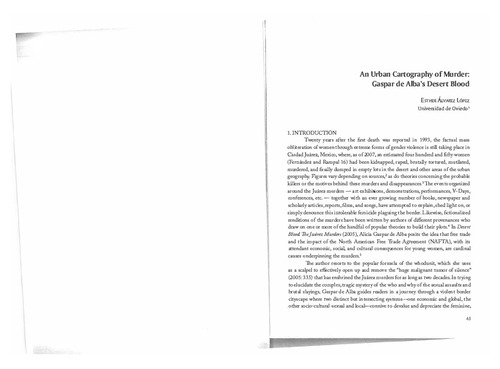An Urban Cartography of Murder: Gaspar de Alba 's Desert Blood
Autor(es) y otros:
Editor/Coord./Trad.:
Palabra(s) clave:
feminicidio
Juárez
Femicide
Fecha de publicación:
Editorial:
Universidad de Alcalá- Instituto Franklin
Citación:
Descripción física:
Resumen:
Twenty years after the first death was reported in 1993, the factual mass obliteration of women through extreme forms of gender violence is still taking place in Ciudad Juárez, México, where, as of 2007, an estimated four hundred and fifty women (Fernández and Rampal 16) had been kidnapped, raped, brutally tortured, mutilated, murdered, and finally dumped in empty lots in the desert and other áreas of the urban geography. In Desert Blood. The Juárez Murders (2005), Alicia Gaspar de Alba posits the idea that free trade and the impact of the North American Free Trade Agreement (NAFTA), with its attendant economic, social, and cultural consequences for Young women, are cardinal causes underpinning the murders. This paper aims to analyze the spatial demarcations that characterize gender and gender relations in the twin cities of Ciudad Juárez and El Paso. Likewise, it will examine the cartography of murder, revealing how violence has become so geographically pervasive that it has en/gendered a faled border cityscape where the impact of globalization, the conflicting terrains of public versus private, and femicide ultimately intersect.
Twenty years after the first death was reported in 1993, the factual mass obliteration of women through extreme forms of gender violence is still taking place in Ciudad Juárez, México, where, as of 2007, an estimated four hundred and fifty women (Fernández and Rampal 16) had been kidnapped, raped, brutally tortured, mutilated, murdered, and finally dumped in empty lots in the desert and other áreas of the urban geography. In Desert Blood. The Juárez Murders (2005), Alicia Gaspar de Alba posits the idea that free trade and the impact of the North American Free Trade Agreement (NAFTA), with its attendant economic, social, and cultural consequences for Young women, are cardinal causes underpinning the murders. This paper aims to analyze the spatial demarcations that characterize gender and gender relations in the twin cities of Ciudad Juárez and El Paso. Likewise, it will examine the cartography of murder, revealing how violence has become so geographically pervasive that it has en/gendered a faled border cityscape where the impact of globalization, the conflicting terrains of public versus private, and femicide ultimately intersect.
ISBN:
Patrocinado por:
The research carried out for the writing ofhis essay is part of the I+D+I project"Emboclied Encounters and Alternative Knowledges: Inhabiting and Creating the City" (MultipllCity), ref. FFI2013-4564-R, funded by the Spanish Ministry of Economy and Competitiveness.
Colecciones
- Capítulos de libros [6478]
- Filología Inglesa, Francesa y Alemana [580]
Ficheros en el ítem





